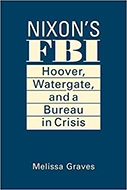Nixon’s FBI: Hoover, Watergate, And A Bureau In Crisis

Author: Melissa Graves
Publisher: Boulder, CO: Lynne Rienner Publishers, 2020. 247p.
Reviewer: Kevin Cassidy | September 2021
From January 20th, 1969 until August 9th, 1974, Richard Nixon served as the 37th President of the United States. These were tumultuous times in America. Students at universities were protesting the Vietnam war, and America was seeking guidance and leadership from its newly elected President. In his inauguration speech, Nixon said “Americans cannot learn from one another until we stop shouting at one another.” He also said: “the greatest honor history can bestow is the title of peacemaker. This honor now beckons America.” Little did he know that less than 5 years later he would be resigning as President of the United States because of the so-called Watergate scandal.
Melissa Graves brilliantly discusses the history of the Watergate scandal, as well as other significant factors including Nixon’s relationship with J. Edgar Hoover, and generally the FBI and other law enforcement agencies. She delves deeply into the relationships forged by Nixon with the FBI and with Hoover’s replacement, L. Patrick Gray. Near the end of Hoover’s directorship, his health was failing, and he had many vocal detractors. Graves writes that despite Hoover’s transgressions and the decline of his authority, he remained steadfast in his beliefs of not compromising the Bureau under any circumstances. This unfortunately was not true of L. Patrick Gray, who was a longtime friend of Nixon’s. What is significant is that the break-in of the Watergate Hotel in 1972 took place six weeks after the death of Hoover – precisely during the early tenure of Mr. Gray.
Graves provides background information that reminds the reader of how agencies such as the Central Intelligence Agency (CIA), the Defense Intelligence Agency (DIA), the National Security Agency (NSA), and the Military Intelligence Agency regarded various protest groups and causes during that time. She describes, for example, how various of these intelligence agencies carried out operations such as monitoring civil rights activist Stokely Carmichael after the assassination of Dr. Martin Luther King Jr., and allegedly spying on a meeting of Catholic priests who opposed the church’s moratorium on birth control.
Throughout the book, dates, names, and background stories are interwoven effectively, thus providing the reader a timeline of historical events. It is this kind of information that captures the attention of a reader and provides historical information that might otherwise remain unknown.
Reviewer: Kevin Cassidy-Professor in the Security, Fire & Emergency Management Department at John Jay College. He also lectures at Slippery Rock University in Pennsylvania. He is a member of ASIS.


